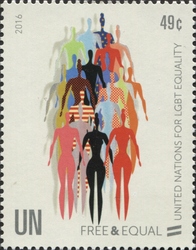Stamp: Free and Equal (United Nations, Offices in New York 2016)
Free and Equal (United Nations, Offices in New York 2016)
05 February (United Nations, Offices in New York ) within release Free and Equal goes into circulation Stamp Free and Equal face value 0.49 United States dollar
| Stamp Free and Equal in catalogues | |
|---|---|
| WADP Numbering System - WNS: | WAD:UN101.16 |
Stamp is vertical format.
Number in set - 2||(show set). Layout - sheet of 20. Issuing - United Nations Postal Administration. Printer - Cartor Security PrintingAlso in the issue Free and Equal:
- Stamp - Free and Equal face value 0.49;
- Stamp - Free and Equal face value 1.20;
Stamp Free and Equal it reflects the thematic directions:
Humans (Homo sapiens, meaning "thinking man") or modern humans are the most common and widespread species of primate, and the last surviving species of the genus Homo. They are great apes characterized by their hairlessness, bipedalism, and high intelligence. Humans have large brains, enabling more advanced cognitive skills that enable them to thrive and adapt in varied environments, develop highly complex tools, and form complex social structures and civilizations. Humans are highly social, with individual humans tending to belong to a multi-layered network of cooperating, distinct, or even competing social groups – from families and peer groups to corporations and political states. As such, social interactions between humans have established a wide variety of values, social norms, languages, and traditions (collectively termed institutions), each of which bolsters human society. Humans are also highly curious, with the desire to understand and influence phenomena having motivated humanity's development of science, technology, philosophy, mythology, religion, and other frameworks of knowledge; humans also study themselves through such domains as anthropology, social science, history, psychology, and medicine. There are estimated to be more than eight billion living humans.
Law is a set of rules that are created and are enforceable by social or governmental institutions to regulate behavior, with its precise definition a matter of longstanding debate It has been variously described as a science and as the art of justice. State-enforced laws can be made by a group legislature or by a single legislator, resulting in statutes; by the executive through decrees and regulations; or established by judges through precedent, usually in common law jurisdictions. Private individuals may create legally binding contracts, including arbitration agreements that adopt alternative ways of resolving disputes to standard court litigation. The creation of laws themselves may be influenced by a constitution, written or tacit, and the rights encoded therein. The law shapes politics, economics, history and society in various ways and also serves as a mediator of relations between people.

